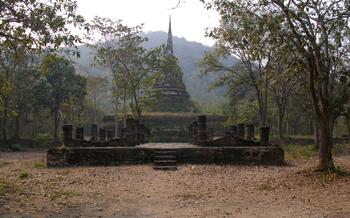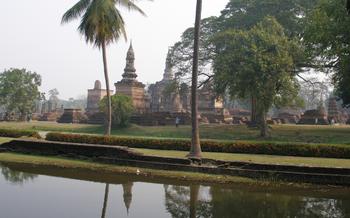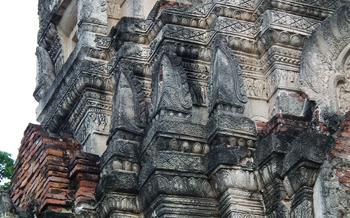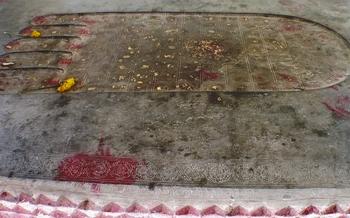
Phitsanulok City Wall and Moat
- Phitsanulok City Wall and Moat: A Historical Legacy
- Exploring the City Walls: A Walk Through Time
- Gates: Portals to the Past
- Bastions: Sentinels of Defense
- Watchtowers: Guardians of Vigilance
- Restoration: Preserving a Legacy
- The Moat: A Serene Waterway
- Phitsanulok Historical Park: A Journey into the Past
- Wat Ratchaburana: A Masterpiece of Architecture
- Wat Phra Si Ratana Mahathat: A Royal Legacy
- Phitsanulok National Museum: A Treasure Trove of History
- Night Market: A Culinary Adventure
- Local Cuisine: A Taste of Phitsanulok
- Accommodation: Finding Your Home Away from Home
- Getting Around: Navigating Phitsanulok
- Public Transportation
- Bicycle Rentals
- Tuk-Tuks
- Renting a Car
- Festivals and Events: Celebrating Phitsanulok's Spirit
- Day Trips from Phitsanulok: Exploring the Region
- Phitsanulok for Families: Creating Unforgettable Memories
- Insider Tip: Discovering Hidden Gems
Phitsanulok City Wall and Moat: A Historical Legacy
Phitsanulok's City Wall and Moat stand as a testament to the city's rich historical legacy. Constructed in the 14th century during the Sukhothai Kingdom, these ancient fortifications served as a vital defense mechanism, protecting the city from invaders and securing its strategic position on the banks of the Nan River. The walls, once adorned with majestic gates and towers, have withstood the test of time, retaining their grandeur despite the passage of centuries.
The moat, a formidable barrier encircling the city, played a crucial role in defense, acting as a natural obstacle to enemy forces. It also served as a vital water source for the city's inhabitants, providing irrigation for agriculture and sustenance for the diverse wildlife that thrived within its depths.
Preservation efforts have been diligently undertaken to maintain these historical landmarks, ensuring their legacy endures. Restoration projects have been implemented to safeguard the integrity of the walls and moat, preserving their original features while adapting them to contemporary needs. These efforts have transformed the City Wall and Moat into a cherished symbol of Phitsanulok's heritage, inviting visitors to step back in time and explore the rich tapestry of the city's past.
The City Wall and Moat have played a pivotal role in shaping Phitsanulok's urban development. The walls demarcated the city's boundaries, providing a sense of security and order. The moat, acting as a natural moat, further enhanced the city's defenses while contributing to its unique character and charm. Today, these historical landmarks continue to serve as a source of pride for the people of Phitsanulok, symbolizing the city's resilience and its deep connection to its roots.
Exploring the City Walls: A Walk Through Time
The Phitsanulok City Walls, standing tall and proud, beckon visitors to embark on a journey through time. These ancient fortifications, once the city's protective shield, now serve as a testament to its rich history and resilience.
Gates: Portals to the Past
The city walls are pierced by four majestic gates, each a unique portal to the past. The Chang Phuak Gate, facing east, greets visitors with its intricate carvings and imposing presence. The Ratchaburi Gate, to the south, stands as a reminder of the city's connection to the ancient kingdom of Ayutthaya. The Suphan Gate, in the west, offers a glimpse into the city's vibrant commercial past, while the Phet Gate, to the north, invites travelers to explore the serene countryside beyond.
Bastions: Sentinels of Defense
Along the walls, bastions stand as silent sentinels, their sturdy forms bearing witness to the city's tumultuous past. These defensive structures, strategically positioned at intervals, provided a formidable barrier against invaders. Their massive walls, pierced with narrow slits, allowed defenders to rain down arrows and other projectiles upon attackers, making the city virtually impregnable.
Watchtowers: Guardians of Vigilance
Rising above the bastions, watchtowers served as the city's eyes, keeping a vigilant watch over the surrounding landscape. These tall, slender structures provided a commanding view of the approaches, enabling guards to spot potential threats from afar. The watchtowers also served as communication hubs, allowing messages and signals to be relayed quickly and efficiently across the city.
Restoration: Preserving a Legacy
In recent years, the Phitsanulok City Walls have undergone extensive restoration efforts, ensuring their preservation for future generations. These projects have involved meticulous cleaning, repairs, and reinforcement of the walls, bastions, and watchtowers. The restoration work has breathed new life into these ancient structures, allowing visitors to appreciate their grandeur and historical significance.
The Moat: A Serene Waterway
Flowing gently around the ancient city walls, the moat of Phitsanulok adds a touch of tranquility to the bustling urban landscape. This serene waterway holds significant historical value, having once served as a defensive barrier against invading forces. Its strategic location made it an integral part of the city's defense system, preventing enemies from easily breaching the city gates.
Over time, the moat's role has evolved, transforming it into a haven for wildlife. The calm waters provide a sanctuary for various species of fish, birds, and other aquatic creatures. Visitors can spot egrets, kingfishers, and cormorants gracefully gliding over the surface, creating a picturesque scene. The moat's lush vegetation further enhances its natural beauty, with towering trees and vibrant flowers lining its banks.
The moat also serves as a recreational retreat for locals and tourists alike. Its peaceful atmosphere invites visitors to take a leisurely stroll along its banks, enjoying the tranquility and serenity of the surroundings. Whether seeking a quiet spot for contemplation or a place to escape the hustle and bustle of city life, the moat offers a welcome respite.
Boat tours are available for those who wish to experience the moat from a different perspective. These tours provide a unique opportunity to admire the city walls from the water, offering stunning views of the ancient fortifications. As the boat glides along the moat, visitors can delve into the history and significance of this remarkable waterway.
Phitsanulok Historical Park: A Journey into the Past
Within the confines of the city walls lies Phitsanulok Historical Park, a treasure trove of ancient temples and palaces that narrate the city's rich history. This park transports visitors back in time, allowing them to explore the architectural wonders that have stood the test of centuries.
Location:
Phitsanulok Historical Park is conveniently situated within the city walls, making it easily accessible on foot or by bicycle. Visitors can enter the park through one of the city gates and embark on a journey through the past.
Cultural Significance:
The park is home to several significant temples and palaces that showcase Phitsanulok's cultural heritage. These structures, with their intricate carvings, towering stupas, and serene Buddha images, provide a glimpse into the city's religious and architectural traditions.
Wat Ratchaburana:
One of the highlights of the park is Wat Ratchaburana, a stunning temple that was built in the 15th century during the Ayutthaya Kingdom. The temple's architecture is a testament to the artistic prowess of the era, featuring intricate carvings, delicate stucco work, and a towering prang.
Wat Phra Si Ratana Mahathat:
Another must-visit temple within the park is Wat Phra Si Ratana Mahathat, which dates back to the Sukhothai Kingdom. Although only ruins remain today, the temple's grandeur can still be felt through its impressive layout and the remnants of its once-magnificent structures.
Wat Ratchaburana: A Masterpiece of Architecture
Wat Ratchaburana, nestled within the Phitsanulok Historical Park, stands as a testament to the architectural prowess of the Ayutthaya Kingdom. Built in the 15th century, this temple captivates visitors with its intricate carvings, towering stupas, and elegant prang. The main prang, rising majestically above the temple grounds, is adorned with exquisite stucco reliefs depicting scenes from the Ramayana epic.
Intricate carvings grace every surface of the temple, showcasing the exceptional craftsmanship of the Ayutthaya artisans. Floral motifs, mythical creatures, and celestial beings intertwine harmoniously, creating a visual feast for the eyes. The stupas, with their graceful curves and delicate finials, add to the temple's overall grandeur.
Inside the temple, visitors can pay homage to the revered Buddha images enshrined within. The principal Buddha image, Phra Buddha Ratchaburana, exudes an aura of serenity and compassion, inviting devotees to seek solace and spiritual guidance. The temple's interior walls are adorned with vibrant murals depicting scenes from Buddhist mythology, offering a glimpse into the rich religious traditions of the past.
Wat Ratchaburana has undergone extensive restoration efforts in recent years, ensuring its preservation for future generations. Visitors can witness the ongoing work to conserve and restore this architectural masterpiece, gaining insights into the intricate processes involved in maintaining Thailand's rich cultural heritage.
Wat Phra Si Ratana Mahathat: A Royal Legacy
Wat Ph's history, dating back to the Sukhothai Kingdom. Its unique architectural features set it apart from other temples in the city. The temple's most striking feature is the bronze Buddha statue, Phra Buddha Chinnarat, which is considered one of the most beautiful Buddha images in Thailand. The statue exudes an aura of serenity and is a testament to the exceptional craftsmanship of the Sukhothai period.
Beyond the Buddha statue, Wat Phra Si Ratana Mahathat boasts several other notable architectural elements. The temple's chedi, or spire, is adorned with intricate carvings and is surrounded by smaller chedis, creating a harmonious ensemble. The temple's ordination hall is also noteworthy for its well-preserved murals depicting scenes from the life of Buddha.
Visitors to Wat Phra Si Ratana Mahathat can explore the ruins of the once-thriving monastic complex that once surrounded the temple. These ruins provide a glimpse into the temple's former grandeur and the important role it played in the religious and cultural life of Phitsanulok.
Phitsanulok National Museum: A Treasure Trove of History
Within the city walls lies the Phitsanulok National Museum, a treasure trove of artifacts and exhibits that narrate the captivating story of Phitsanulok's rich past. The museum's diverse collections showcase the region's cultural heritage, from ancient pottery and sculptures to religious objects that provide a glimpse into the spiritual beliefs of the past. Interactive displays bring history to life, offering visitors an immersive experience as they delve deeper into the fascinating tales of Phitsanulok's journey through time.
Night Market: A Culinary Adventure
As the sun sets over Phitsanulok, the city transforms into a vibrant culinary paradise, with the night market emerging as a must-visit destination for food enthusiasts. Located near the city walls, the night market is a bustling hive of activity, where locals and tourists alike gather to savor the delectable flavors of Phitsanulok's street food.
From grilled meats that sizzle on open fires to sticky rice and mango, the market offers a tantalizing array of local delicacies. Visitors can indulge in the smoky aroma of satay, savor the crispy perfection of fried spring rolls, or treat their taste buds to the sweet and tangy flavors of pad thai.
Beyond the food, the night market is also a shopper's paradise, with stalls selling a variety of souvenirs, handicrafts, and local products. From intricately carved wooden figurines to colorful textiles and handmade jewelry, there's something for everyone to find.
As the night wears on, the atmosphere at the night market becomes electric, with the sound of live music filling the air and the laughter of locals and tourists mingling. It's the perfect place to soak up the vibrant energy of Phitsanulok and experience the city's culinary delights.
Local Cuisine: A Taste of Phitsanulok
Phitsanulok's culinary scene is a captivating blend of flavors and textures, offering a unique gastronomic experience. Khao Soi Phitsanulok, a rich and creamy coconut-based curry noodle soup, is the city's signature dish and a must-try for any foodie. Khanom Chin Nam Ngeo, a refreshing rice noodle salad, is another local favorite, known for its tangy and spicy broth. For a taste of grilled goodness, indulge in Moo Ping, succulent skewers of marinated pork, or Som Tum, a spicy green papaya salad that packs a punch.
Phitsanulok's vibrant Night Market is a culinary paradise, where visitors can savor the aromas of grilled meats, sticky rice with sweet mango, and other local delicacies. Fresh ingredients are sourced from local markets, where vendors display an array of colorful fruits, vegetables, and spices. Cooking classes are also available for those who wish to learn the art of traditional Thai cuisine and recreate these flavors at home. Vegetarian travelers will find plenty of meat-free options, such as Khao Neeo Mamuang, sweet sticky rice with ripe mango, and Pad Pak Bung, stir-fried morning glory.
Accommodation: Finding Your Home Away from Home
When planning your stay in Phitsanulok, you'll find a diverse range of accommodation options to suit every budget and preference. For budget-conscious travelers, there are numerous guesthouses and hostels that offer basic yet comfortable lodgings at affordable rates. These establishments often provide a communal atmosphere, allowing you to meet fellow travelers and share experiences.
For those seeking a balance between comfort and affordability, mid-range hotels offer a great option. These hotels typically provide private rooms with modern amenities, such as air conditioning, Wi-Fi, and en-suite bathrooms. They often have convenient locations, making it easy to explore the city's attractions.
If you're looking for a truly indulgent experience, Phitsanulok also boasts several upscale hotels and resorts. These establishments offer luxurious accommodations, often with stunning views of the city or the surrounding countryside. They also feature amenities such as swimming pools, spas, and fine dining restaurants, ensuring a memorable and pampered stay.
For those seeking a unique and authentic experience, Phitsanulok offers several charming guesthouses and homestays. These accommodations provide a glimpse into local life and culture, allowing you to interact with friendly hosts and experience traditional Thai hospitality. Whether you prefer a budget-friendly option, a comfortable mid-range hotel, a luxurious resort, or a unique homestay, Phitsanulok has something to offer every traveler.
Getting Around: Navigating Phitsanulok
Public Transportation
Phitsanulok has an efficient public transportation system that makes it easy to get around the city. Buses are the most common form of public transportation, and they cover a wide range of routes. Tickets are affordable, and buses run frequently.
Bicycle Rentals
Biking is a great way to explore Phitsanulok at a leisurely pace. Several bike rental shops are located throughout the city, and they offer a variety of bikes to choose from.
Tuk-Tuks
Tuk-tuks are a fun and affordable way to get around Phitsanulok. These three-wheeled vehicles are ubiquitous in Thailand, and they can be found at most major intersections. Tuk-tuk drivers are usually happy to negotiate a price, so don't be afraid to haggle.
Renting a Car
Renting a car is a great option for travelers who want the freedom to explore Phitsanulok and its surroundings at their own pace. Several car rental agencies are located at the airport and in the city center.
Festivals and Events: Celebrating Phitsanulok's Spirit
Phitsanulok comes alive during its vibrant festivals and events, showcasing the city's rich cultural heritage and traditions.
The most famous festival is Loi Krathong and Yi Peng, held annually in November. During this festival, locals release beautifully decorated floating lanterns (krathongs) and sky lanterns (khom loi) into the sky, creating a magical spectacle of lights.
Songkran, the Thai New Year, is celebrated in April with lively water-splashing festivities. The streets are filled with revelers of all ages, playfully throwing water at each other to mark the beginning of the new year.
Throughout the year, various local fairs and markets are held in Phitsanulok, offering a glimpse into the city's vibrant local culture. These events showcase traditional handicrafts, local delicacies, and cultural performances, providing an immersive experience for visitors.
Immerse yourself in the festive spirit of Phitsanulok and join the locals in celebrating these vibrant events that bring the city to life.
Day Trips from Phitsanulok: Exploring the Region
Phitsanulok, a city steeped in history and culture, serves as a gateway to exploring the surrounding region. History enthusiasts can embark on a journey to Sukhothai Historical Park, a UNESCO World Heritage Site that showcases the grandeur of the ancient Sukhothai Kingdom. Marvel at the well-preserved temples, stupas, and Buddha images that tell the story of a once-thriving civilization.
Another UNESCO-listed site, Sri Satchanalai Historical Park, awaits with its impressive collection of temples, city walls, and moats. Immerse yourself in the serene atmosphere as you wander through the ruins and imagine the bustling city that once stood here.
For nature lovers, a trip to Khao Kho offers a refreshing escape. Nestled amidst rolling hills and lush greenery, this mountainous region is known for its stunning scenery. Embrace the cool climate, explore the cascading waterfalls, and immerse yourself in the beauty of nature's wonders.
Phitsanulok for Families: Creating Unforgettable Memories
Phitsanulok offers a wealth of attractions and activities that cater to families with children, making it an ideal destination for a memorable vacation. The city boasts several parks and playgrounds where kids can run, play, and have fun. These green spaces provide a welcome respite from the hustle and bustle of city life, allowing families to relax and bond while enjoying the outdoors.
Families seeking educational experiences can engage in interactive learning at Phitsanulok's museums and cultural centers. These institutions offer a range of exhibits and programs that bring history, culture, and science to life, providing children with hands-on learning opportunities.
When selecting accommodation, families should consider hotels and resorts that offer amenities and services tailored to their needs. Many family-friendly accommodations in Phitsanulok feature spacious rooms, interconnecting rooms, and kids' clubs, ensuring a comfortable and enjoyable stay for all.
To make the most of their trip, families should plan an itinerary that includes a mix of cultural exploration, outdoor adventures, and family-friendly activities. This could involve visiting temples, exploring the city's historical sites, taking a boat ride along the moat, or embarking on a cycling tour through the countryside.
With its rich cultural heritage, beautiful natural surroundings, and abundance of family-friendly attractions, Phitsanulok promises an unforgettable vacation for families of all ages.
Insider Tip: Discovering Hidden Gems
Beyond the popular attractions, Phitsanulok holds a treasure trove of hidden gems waiting to be discovered. For those seeking a more off-the-beaten-path experience, here are some insider tips:
-
Secret Temples: Venture beyond the well-known temples to uncover lesser-known gems that offer a tranquil escape from the crowds. Explore ancient ruins tucked away in quiet neighborhoods or seek out hidden temples nestled amidst lush greenery.
-
Local Eateries: Step away from the touristy restaurants and delve into the local culinary scene. Ask local residents for recommendations or explore the backstreets to find hidden eateries that serve authentic Phitsanulok cuisine. Sample delicious local delicacies and engage with friendly locals for a truly immersive experience.
-
Hidden Viewpoints: Discover secret spots that offer panoramic views of the city and its surroundings. Climb to the top of a hill or seek out rooftop terraces to capture breathtaking vistas. Enjoy stunning sunsets over the Phitsanulok River or marvel at the city skyline illuminated at night.




